Related Research Articles

Victoria station, also known as London Victoria, is a central London railway terminus and connected London Underground station in Victoria, in the City of Westminster, managed by Network Rail. Named after the nearby Victoria Street, the main line station is a terminus of the Brighton Main Line to Gatwick Airport and Brighton and the Chatham Main Line to Ramsgate and Dover via Chatham. From the main lines, trains can connect to the Catford Loop Line, the Dartford Loop Line, and the Oxted line to East Grinstead and Uckfield. Southern operates most commuter and regional services to south London, Sussex and parts of east Surrey, while Southeastern operates trains to south-east London and Kent, alongside limited services operated by Thameslink. Gatwick Express trains run direct to Gatwick. The Underground station is on the Circle and District lines between Sloane Square and St James's Park, and the Victoria line between Pimlico and Green Park. The area around the station is an important interchange for other forms of transport: a local bus station is in the forecourt and Victoria Coach Station is nearby.

Crystal Palace railway station is a Network Rail and London Overground station in the London Borough of Bromley in south London. It is located in the Anerley area between the town centres of Crystal Palace and Penge, 8 miles 56 chains (14.0 km) from London Victoria. It is one of two stations built to serve the site of the 1851 exhibition building, the Crystal Palace, when it was moved from Hyde Park to Sydenham Hill after 1851.

The London, Brighton and South Coast Railway was a railway company in the United Kingdom from 1846 to 1922. Its territory formed a rough triangle, with London at its apex, practically the whole coastline of Sussex as its base, and a large part of Surrey. It was bounded on its western side by the London and South Western Railway (L&SWR), which provided an alternative route to Portsmouth. On its eastern side the LB&SCR was bounded by the South Eastern Railway (SER)—later one component of the South Eastern and Chatham Railway (SE&CR)—which provided an alternative route to Bexhill, St Leonards-on-Sea, and Hastings. The LB&SCR had the most direct routes from London to the south coast seaside resorts of Brighton, Eastbourne, Worthing, Littlehampton and Bognor Regis, and to the ports of Newhaven and Shoreham-by-Sea. It served the inland towns and cities of Chichester, Horsham, East Grinstead and Lewes, and jointly served Croydon, Tunbridge Wells, Dorking and Guildford. At the London end was a complicated suburban and outer-suburban network of lines emanating from London Bridge and Victoria, and shared interests in two cross-London lines.

The London, Chatham and Dover Railway was a railway company in south-eastern England created on 1 August 1859, when the East Kent Railway was given parliamentary approval to change its name. Its lines ran through London and northern and eastern Kent to form a significant part of the Greater London commuter network. The company existed until 31 December 1922 when its assets were merged with those of other companies to form the Southern Railway as a result of the grouping determined by the Railways Act 1921. The railway was always in a difficult financial situation and went bankrupt in 1867, but was able to continue to operate. Many of the difficulties were caused by the severe competition and duplication of services with the South Eastern Railway (SER). However, in 1898 the LCDR agreed with the SER to share the operation of the two railways, work them as a single system and pool receipts: but it was not a full amalgamation. The SER and LCDR remained separate companies with separate shareholders until both becoming constituents of the Southern Railway on 1 January 1923.

Beckenham Junction is the main railway and tram station in Beckenham in the London Borough of Bromley, south London. The railway stop is on the Chatham Main Line, 8 miles 53 chains (13.9 km) down the line from London Victoria and situated between Kent House and Shortlands. The tram stop is one of the eastern termini of Tramlink.

The Brighton Main Line is a railway line in southern England linking London to Brighton. It starts at two termini in the capital, London Victoria and London Bridge, and the branches from each meet at East Croydon, from where the route continues southwards via Gatwick Airport to the coast. The line serves the suburbs of South London as well as the towns of Redhill, Horley, Crawley, Haywards Heath and Burgess Hill.

Forest Hill railway station serves Forest Hill in the London Borough of Lewisham, south London. The station adjoins a road which serves as part of the A205 South Circular Road.

The East Kent Railway (EKR) was an early railway operating between Strood and Faversham in Kent, England, during 1858 and 1859. In the latter year it changed its name to the London, Chatham and Dover Railway to reflect its ambitions to build a rival line from London to Dover via Chatham and Canterbury. The line as far as Canterbury was opened in 1860 and the extension to Dover Priory on 22 July 1861. The route to London Victoria station via the Mid-Kent line and the West End of London and Crystal Palace Railway opened on 1 November 1861.
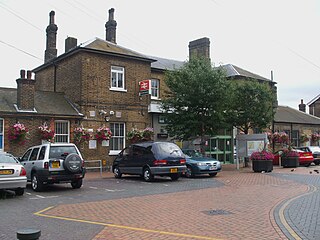
Norwood Junction railway station is a National Rail station in South Norwood in the London Borough of Croydon, south London, and is in Travelcard Zone 4. It is 8 miles 55 chains down the line from London Bridge.

Tulse Hill railway station is in the Tulse Hill area of the London Borough of Lambeth in south London, between railway bridges over the A205, South Circular Road and the A215, Norwood Road. It is 5 miles 2 chains (8.1 km) measured from London Victoria. At the moment, there are 4 platforms, each long enough for 8 coaches.

Shortlands railway station is in Shortlands, in the London Borough of Bromley in south London. It serves the southwest part of Bromley, and is 10 miles 3 chains (16.2 km) down the line from London Victoria. The station is located on the A222 road. Shortlands Junction, just west of the station, is where the Catford Loop Line joins the Chatham Main Line: the two lines are split into slow and fast pairs through the station, which consists of two island platforms on an embankment. The station is in London Travelcard Zone 4, and the station is managed by Southeastern and trains are operated by Southeastern and Thameslink.
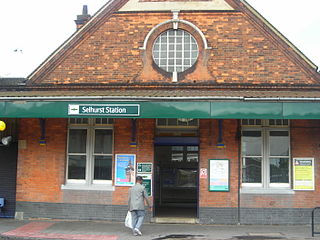
Selhurst railway station is in the London Borough of Croydon in south London, 9 miles 31 chains (15.1 km) along the line from London Victoria. It is operated by Southern, which also provides all the train services. The station is in Travelcard Zone 4.

Wandsworth Common railway station is in the London Borough of Wandsworth in south London. It is 4 miles 5 chains (6.5 km) down the line from London Victoria.
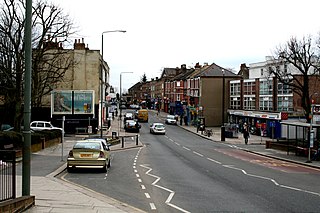
Anerley is an area of south east London, England, within the London Borough of Bromley. It is located 7 miles (11 km) south south-east of Charing Cross, to the south of Crystal Palace and Upper Norwood, west of Penge, north of Elmers End and South Norwood.

Grosvenor Road station was a railway station in London located at the north end of Grosvenor Bridge on the approach tracks to Victoria station. Victoria station was originally operated as two separate parts served by the London, Chatham and Dover Railway (LC&DR) and the London, Brighton and South Coast Railway (LB&SCR) and Grosvenor Road station was also operated in this way. The LC&DR station operated between 1867 and 1911 and the LB&SCR station operated between 1870 and 1907. The station building of the LC&DR station remains on the eastern side of the tracks adjacent to Grosvenor Road (A3212) although no platforms remain at the elevated track level.

The Crystal Palace and South London Junction Railway (CPSLJR) was built by the London, Chatham and Dover Railway (LCDR) from Brixton to Crystal Palace High Level to serve the Crystal Palace after the building was moved to the area that became known as Crystal Palace from its original site in Hyde Park.
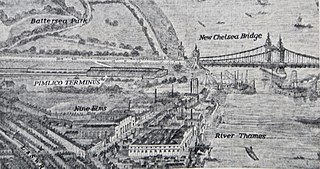
Pimlico terminus was a railway station built beside the new Chelsea Bridge, across the road from the new Battersea Gardens. It was at the end of a 3 mi 20 ch (5.2 km) extension of the West End of London and Crystal Palace Railway from Wandsworth Common. Confusingly, the station was not actually in Pimlico, which is on the other (northern) bank of the river; to reach it, Pimlico residents had to cross Chelsea Bridge which opened a week after the station.
The West London Railway was conceived to link the London and Birmingham Railway and the Great Western Railway with the Kensington Basin of the Kensington Canal, enabling access to and from London docks for the carriage of goods. It opened in 1844 but was not commercially successful.
The Victoria Station and Pimlico Railway was an early British railway company which was incorporated by Act of Parliament 23 July 1858. to build a railway line connecting the existing London Brighton and South Coast Railway (LB&SCR) terminus in Battersea to a new terminal at London Victoria station in Westminster. This involved constructing the Grosvenor Bridge over the river Thames. The company later leased its lines and stations to the LB&SCR and the London Chatham and Dover Railway (LC&DR) but continued in existence until December 1922 when it was briefly amalgamated with the South Eastern Railway as a result of the Railways Act 1921, which created the Big Four on 1 January 1923.
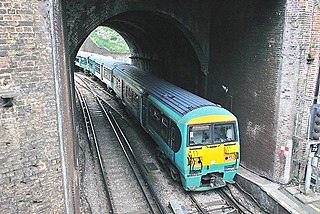
The Crystal Palace Line is a railway line in London which runs from Balham Junction to Beckenham Junction. The engineer's reference for this line is BBJ.
References
- ↑ Gray, Adrian (1977). The London to Brighton Line 1841-1977. Blandford Forum: Oakwood Press. pp. 41–9.
- ↑ Gray, 1977 p.54.
- ↑ "The Railways of Beckenham", Andrew Hajducki, 2011[ page needed ]